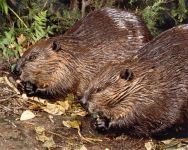


|

|
|
 
|

We thank all who have supported the Refuge this year
We wanted to thank everyone who helped the Refuge this year, whether by donations, volunteering for various projects, writing on behalf of wildlife issues or helping us patrol our borders. We could have sent each of you a card... we really would have liked to do this. Then we calculated the cost and realized that this would wipe out a large portion of the donations from many of you and did not think this would be in the best interests of the Refuge, wildlife or your generosity. Instead, we thank you here, sincerely, for everything you have done on behalf of wildlife in general and the Refuge in particular! We could not continue without you.

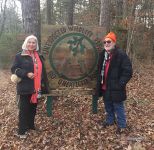
Awesome volunteers
New Jersey's six-day firearm killing 'season' is always our busiest and our most important week of patrol. Of course, we patrol all year round, not just during periods when New Jersey determines it is legal to kill wildlife. For example, we have to be particularly vigilant that people do not violate our many waterways through fishing.
So far this year, we have had many wonderful volunteers patrolling the Refuge and helping us keep the animals (and plants) at the Refuge safe from human intruders. This year, we dished out vegan chili and tortilla chips and provided hot cups of coffee and tea to warm our patrollers during the cool, rainy days. Although we appreciate every one of these people, we do not have room to acknowledge them all. Here are photos of just a few: Judy Horowitz and Howard Rosenblatt standing next to our sign and Mary Ann Gurka along one of our trails.

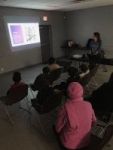
Unexpected Wildlife Refuge presentation on animals at local afterschool program
I was thrilled to be invited this month to speak about wildlife to a group of elementary school children at an afterschool program in Newfield, NJ. I brought many photos and stories, but the kids 'ran' the show. These children had many interesting, smart and funny questions which kept me talking for forty minutes longer than I was scheduled. Some of my favorite topics of the evening were:
These and other questions reinforced the fact that kids are naturally curious about the world around them. It also reminded me just how important it is that we – the Refuge and others – ensure that children are provided with a non-homocentric view of the world, instilling in them respect and tolerance for other life with whom we only share, not own, this planet.
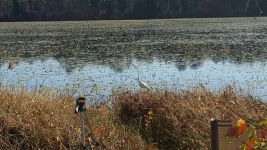
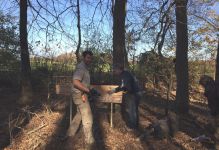
Pinelands Protection Alliance and UWR team up to make new trail signs for the Refuge
We have many beautiful, hand-made signs marking our various trails at the Refuge. Nature, however, considers them to be just one more thing to revert to a natural state. As a result, some of the signs have deteriorated to the point of being illegible or having simply fallen apart. When Jason Howell of the Pinelands Protection Alliance (PPA) asked me, "Is there anything the Refuge needs?", I immediately replied, "New trail signs!". True to his implied promise, he and other wonderful volunteers from the PPA stepped up to help. Jason found rough red and white cedar planks and carved out some new signs. Because we no longer allow trees to be assaulted with nails, Jason designed the new signs so that they can be attached to wooden posts inserted into the ground. We greatly appreciated the work by the PPA people to provide us with great-looking signs, installed in strategic areas to make trail navigation much easier for patrollers and guests. The first photo shows Jason Howell, Mike Hickey and Paula Yudkowitz busy with the installation.
While our volunteers took a short coffee break by the pond, they spotted a great egret only a few feet from our sitting area by the water. Jason was able to get this lovely photo and shared it with us.

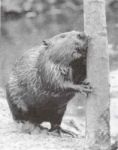
Request from a New Jersey resident asking for help with a beaver family
Because of our knowledge of and advocacy for beavers, we are often called upon to help people solve 'problems' caused by these large and lovable rodents. Recently, a homeowner near Vorhees, NJ, alerted us that his neighbor had contacted New Jersey Fish and Wildlife to employ a trapper to remove a family of beavers from a small, human-made lake behind some homes. I was able to directly communicate with the neighbor and found out he was concerned that the beavers would destroy all the trees around the pond. I pointed out that generally, beavers are beneficial to human interests and that there were ways to mitigate any perceived problems without harming the beavers. I explained how to protect the few trees about which the neighbor was most concerned. Although the neighbor was hoping for 'humane' or live-trapping, because winter was imminent, I told him this might result in death through starvation because the dislocated beavers would not have time to find, refurbish or build a new lodge or store enough food to provide sustenance until spring. He agreed to not disturb the beavers over the winter and to call us in the spring to start doing some fencing around trees. We look forward to working with him then.
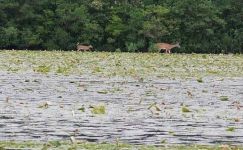
Concern about an 'orphaned' deer
We field many calls about 'orphaned' or 'abandoned' animals, particularly in the spring. Almost always, a young one found alone is not an orphan, rather is just there waiting for parents to return from foraging for food. When we get these calls, it gives us the opportunity to educate people and urge them to not interfere with these babies unless there is evidence that the parents are not returning. The latest call was just recently, presenting a different situation. A woman was on a highway near Egg Harbor, NJ, and saw a young deer only yards away from the body of a doe who apparently had been killed by a vehicle. I told the person that, although this youngster could be considered an 'orphan', because he or she was now several months old, it was likely that they were self-reliant. I explained that attempting to catch her or him might ultimately be far more harmful than letting nature take its course. Deer are easily stressed and this can quickly lead to distress with shock and death as a result.
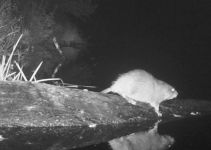
Muskrat neighbor
For weeks during the evenings, we saw someone who appeared to be a small beaver, swimming busily in the middle of one of our many ponds. While this individual was nosing around a favored perch of the local turtles, she managed to photograph herself by a trail camera. We were delighted to see that she was a resident muskrat.
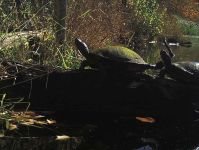
Red-bellied turtles and basking log
There is a favored basking log used by turtles in one of the ponds. Because the turtles were very wary of intruders, all I was able to see in my daily walks was the tail end of one or more turtles as they slid into the water. Hoping to learn which species was involved, I placed a trail camera nearby. It soon became apparent that the log was being used by endangered red-bellied turtles. In one comical – to human beings – video sequence, a large individual was basking for almost 40 minutes when a newcomer arrived to take advantage of the warm spot in the sun. Apparently not in a sharing mood, the larger one spent the next 15 minutes slowly extending his back leg, seen in the photo, into the face of the new arrival in an effort to dislodge him from the log.
Bald eagle family at the Refuge
Last fall, I was excited to see what appeared to be a mated pair of bald eagles. They were flying and swooping together, almost synchronized, like small stunt planes at an air show. I was disheartened not to see them this summer, fearing that they might have left to find another place to call home. A few weeks ago, however, they reappeared at the pond – this year with a juvenile who was never far from their sight. They are now seen daily, fishing and calling together and then roosting in a tall tree across the pond. Unfortunately, I have not been able to get any good photographs. My hope is that one of our 'regular' photographers will visit soon and be able to provide us with photos before the eagles migrate. If that happens, I will be sure to share them with you on Facebook, our Web site or a future newsletter.
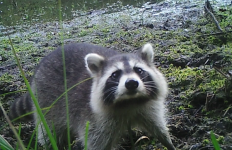
Raccoon inspecting trail camera
It is a good day when a raccoon "discovers" one of our trail cameras. These inquisitive individuals always give us the best close-ups! This mother had two small, chubby siblings in tow. In case you are not familiar with raccoon family life, they will stay together – sleeping, foraging and exploring their environs – until the young are about a year old. After this, the youngsters have to make their own way in the world.

Continuing reminder about helping us help wildlife today
This Refuge and its nearly 800 acres of rigorously protected habitat, is home and sanctuary for hundreds of animal and plant species; many of the animal species have been here for generations. We depend entirely on the support of our donors! The Refuge – and the wildlife living here – could not exist without you. We know that you have limited resources and need to consider which of numerous worthwhile causes to support. We hope, however, that you can again find it possible to give us a donation – today – of any amount. We need your support right now. Our small operating costs continue to exceed our donations.
Helping wildlife and the Refuge in the future
We remind you to please remember Unexpected Wildlife Refuge when planning your will and estate. It is an easy, effective and lasting way to help the Refuge... and wildlife. When talking with your estate planner, just provide them with our name, address and tax identification number (23-7025010). This is one of the most important gifts the Refuge can receive. If you have already included us in your future plans, thank you!
Our newsletters are the result of a team effort involving people dedicated to protecting wildlife in general and furthering the Refuge in particular:
Unexpected Wildlife Refuge
Mailing address: P.O. Box 765, Newfield, NJ 08344-0765
Web site: http://unexpectedwildliferefuge.org/
E-mail: manager@unexpectedwildliferefuge.org
Telephone: 856.697.3541
Facebook: https://www.facebook.com/UnexpectedWildlifeRefuge
Instagram: https://www.instagram.com/Unexpected_Wildlife_Refuge/

